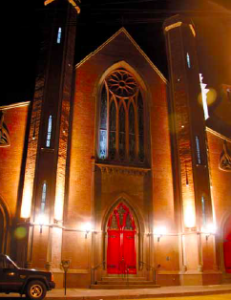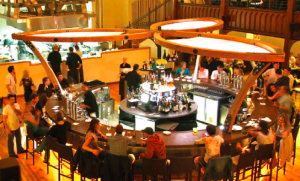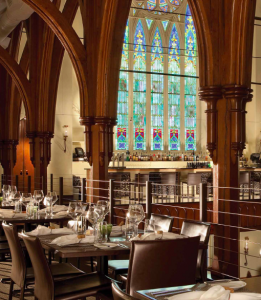A Restaurateur Saves a Historic Church from Obscurity
 Portland, Maine, is known as the “beautiful city by the sea.” In 1982, it was listed on the National Register of Historic Places because of its residents’ willingness to embrace Portland’s long history of beautiful architecture. Among the most popular architectural styles are Victorian and Gothic, which were followed by several locally renowned architects, including Charles A. Alexander.
Portland, Maine, is known as the “beautiful city by the sea.” In 1982, it was listed on the National Register of Historic Places because of its residents’ willingness to embrace Portland’s long history of beautiful architecture. Among the most popular architectural styles are Victorian and Gothic, which were followed by several locally renowned architects, including Charles A. Alexander.
One of Alexander’s beloved creations is a circa 1856 10,000-square-foot Gothic Revival church that stands next to City Hall. It withstood Portland’s great fire of 1866 while half the city’s churches and commercial buildings, as well as hundreds of homes, were destroyed. Despite the love the Methodist congregation had for its church, membership dwindled until the congregation could no longer afford the upkeep. The church was abandoned in 2005 and stood vacant for several years until a real-estate agent showed it to Anne Verrill.
Verrill already owned the successful Foreside Tavern, a family-friendly restaurant in Falmouth, Maine. Her concept for a second restaurant included serving higher-end dishes in a boutique-like space. “We searched for years and had given up,” Verrill remembers. “The restaurant market in Portland is incredibly competitive, so we had to find a place that would really make us different, but we couldn’t find that space.”
When the real-estate agent walked her into the abandoned church, Verrill knew it was exactly what she had been looking for. The space was beautiful and provided plenty of inspiration for a new restaurant. For example, the restaurant’s name, Grace, pays homage to the former church. Triquetra-shaped stained-glass windows became the pattern for Grace’s logo and were replicated in a unique awning above the downstairs bar. “These windows are old leaded stained glass and were misshapen to the point where they didn’t even look like stained glass anymore,” Verrill says. “They bowed so badly we were amazed they didn’t blow out. Not only were they pretty and a perfect logo shape, but the fact that they withstood years of weather without breaking inspired us.”
Verrill’s goal was to restore the church to its original beauty while upgrading it with modern amenities suited to a highend restaurant. Despite being a straightforward goal, it did not come without challenges, some of which had nothing to do with the building. For example, Verrill says filing for and receiving historic tax credits was “traumatic.” “We literally got the credits at the 11th hour,” she remembers. “It is such a positive program but it is so hard to get—as it should be. It’s a lot of money we’re talking about.”
Verrill had built the historic tax credits into her business plan, so her budget depended on them. “Our budget increased quite a bit when we ran into things we didn’t see coming, like the weather at one point was very cold,” she recalls. “Nobody could work and nothing was drying outside the building, but we were still paying. If we didn’t have the tax credits, it would’ve been difficult.” Verrill adds the state’s refund for historic preservation is spread across four years, which has been especially helpful for the new business.
From the time Verrill purchased the building it took about a year and a half to finance the project and complete the renovation work. The building was in excellent structural shape; however, it needed an HVAC system and major electrical upgrades. In addition, the exterior Connecticut brownstone, which features colorful swirls of black, brown, gray and red, and its mortar needed extensive repairs. Matching the stonework as required by historic-preservation guidelines took some time. “We basically took the space that was already there and made it sound again, which shouldn’t have taken terribly long,” Verrill explains. “When you’re four months into finding a mortar color that has the right amount of speckled dust in it, it gets a bit frustrating.”
 Inside the building, Verrill found a purpose for nearly everything. Pews were re-covered and reused as bench seating. The former pulpit acts as the host stand. Copper rods from inside the organ’s keyboard were repurposed into napkin rings. Rust was removed from ornate floor vents before they were painted and placed on the front of the upstairs bar. “Literally any odd or end we could turn into something, we did,” Verrill says.
Inside the building, Verrill found a purpose for nearly everything. Pews were re-covered and reused as bench seating. The former pulpit acts as the host stand. Copper rods from inside the organ’s keyboard were repurposed into napkin rings. Rust was removed from ornate floor vents before they were painted and placed on the front of the upstairs bar. “Literally any odd or end we could turn into something, we did,” Verrill says.
There were many times Verrill thought she had undertaken more than she could handle with the church’s renovation, but it has become a major source of pride for her and for Portland. “When I think about how amazing it is to have a building that was designed and built so long ago by people who did not have any of the technology or machinery we have today, I am very proud,” she explains. “There are buildings all over the country that are just crumbling to the ground because we aren’t reusing them. This building is going to be a significant part of Portland for at least another 100 years. I’m so happy we could make something good out of something old but so beautiful.”


